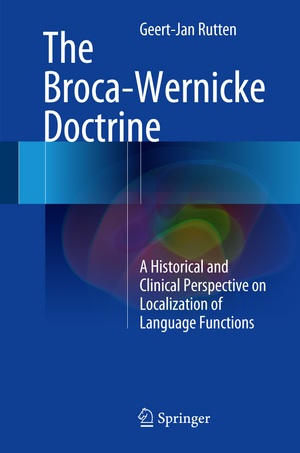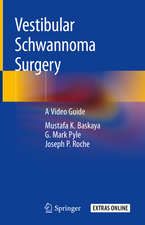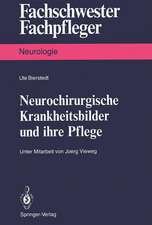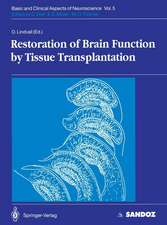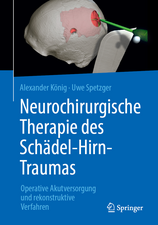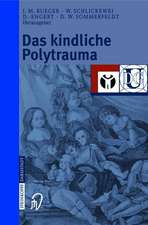The Broca-Wernicke Doctrine: A Historical and Clinical Perspective on Localization of Language Functions
Autor Geert-Jan Ruttenen Limba Engleză Hardback – 25 iul 2017
This is a fascinating paradox: why do neurologists and neurosurgeons continue to use these iconic language models in everyday decision-making? In this book, the author uses his background as a neurosurgeon and a neuroscientist to provide some answers to this question.
The book acquaints clinicians and researchers with the many different aspects of language representation in the brain. It provides a historical overview of functional localisation, as well as insights into the misjudgements that have kept the localist doctrine alive. It creates an awareness of the need to integrate clinical observations and neuroscientific theories if we want to progress further in clinical language research and patient care.
| Toate formatele și edițiile | Preț | Express |
|---|---|---|
| Paperback (1) | 834.79 lei 38-44 zile | |
| Springer International Publishing – 12 sep 2018 | 834.79 lei 38-44 zile | |
| Hardback (1) | 1041.96 lei 3-5 săpt. | |
| Springer International Publishing – 25 iul 2017 | 1041.96 lei 3-5 săpt. |
Preț: 1041.96 lei
Preț vechi: 1096.80 lei
-5% Nou
Puncte Express: 1563
Preț estimativ în valută:
199.37€ • 208.16$ • 165.01£
199.37€ • 208.16$ • 165.01£
Carte disponibilă
Livrare economică 15-29 martie
Preluare comenzi: 021 569.72.76
Specificații
ISBN-13: 9783319546322
ISBN-10: 3319546325
Pagini: 300
Ilustrații: XVII, 306 p. 111 illus., 38 illus. in color.
Dimensiuni: 155 x 235 x 23 mm
Greutate: 0.69 kg
Ediția:1st ed. 2017
Editura: Springer International Publishing
Colecția Springer
Locul publicării:Cham, Switzerland
ISBN-10: 3319546325
Pagini: 300
Ilustrații: XVII, 306 p. 111 illus., 38 illus. in color.
Dimensiuni: 155 x 235 x 23 mm
Greutate: 0.69 kg
Ediția:1st ed. 2017
Editura: Springer International Publishing
Colecția Springer
Locul publicării:Cham, Switzerland
Cuprins
0. PREFACE.- Personal experience.- What we can learn from (everyday) patient cases.- Classical authors with modern opinions.- 1. BROCA & THE BIRTH OF LOCALIZATION THEORIES.- Gall.- Flourens.- Bouillaud & Broca.- 2. WERNICKE & CONNECTIONISM.- Meynert.- The symptom-complex of aphasia, part I.- The symptom-complex of aphasia, part II.- The symptom-complex of aphasia, part III.- 3. APHASIA AND/OR AGNOSIA ?.- Lissauer.- Freund.- 4. THE DIAGRAM MAKERS AND THEIR CRITICS.- Lichtheim.- Kussmaul.- Hughlings Jackson.- Freud.- Marie, Head & the decline of localism.- 5. NAMING AND NUMBERING THE CONVOLUTIONS.- Ecker, Leuret & Gratiolet: order out of chaos.- Microscopic carthography.- Brodmann & Campbell’s view on Broca’s area.- Language areas defined in terms of gyri and sulci.- The planum temporale.- Some concluding remarks.- 6. MAPPING AND LESIONING THE LIVING BRAIN.- Fritsch & Hitzig.- Ferrier.- Sherrington: the primate motor strip.- Krause, Foerster &Penfield : the human motor strip.- Bartholow & Cushing: first experiences from conscious patients.- Penfield’s speech and brain mechanisms.- Ojemann: expanding the language territory.- Duffau: subcortical pathways & hodology.- Electrical stimulation mapping: gold standard.- 7. NEO-CONNECTIONISM, NEURODYNAMICS & LARGE-SCALE NETWORKS.- Geschwind.- Luria.- Computational models & parallel processing.- Language and evolution.- Homologue language areas in non-human primates.- More recent language models: Mesulam, Hickok & Poeppel.- The phonological loop.- 8. FUNCTIONAL NEUROIMAGING.- Early landmark studies.- Beyond single word processing.- A comparison to classic language models.- Intersubject variability.- The problem of averaging.- Hemispheric dominance.- 9. NEURAL PLASTICITY & REHABILITATION.- Early studies.- Diaschisis.- Equipotentiality.- Lashley.- Critical period.- 10. BEYOND LANGUAGE FUNCTIONS.- 11. SYNOPSIS.
Recenzii
“Geert-Jan Rutten’s book The Broca-Wernicke Doctrine offers an extraordinary journey through language localization, symptomatology, and its history. … After reading this book, the reader will have a broad panorama of language in neuroscience … . A must read for each neurosurgeon interested in the field of aphasia and also in localization of brain function.” (Adrien Thomas May and Karl Schaller, Acta Neurochirurgica, Vol. 160 (2), February, 2018)
“Geert-Jan Rutten seeks to clarify historical and current concepts of how brain regions relate to language and other functions. The result is an entertaining and enlightening tour of the history of cerebral neuroscience. … This book is clearly targeted to neurosurgeons and neuroscientists and includes an appropriate level of scientific detail, yet it is consistently engaging and easy to read with logical organization and excellent summaries.” (Jonathan Miller, Neurosurgery, January, 2018)
“Geert-Jan Rutten seeks to clarify historical and current concepts of how brain regions relate to language and other functions. The result is an entertaining and enlightening tour of the history of cerebral neuroscience. … This book is clearly targeted to neurosurgeons and neuroscientists and includes an appropriate level of scientific detail, yet it is consistently engaging and easy to read with logical organization and excellent summaries.” (Jonathan Miller, Neurosurgery, January, 2018)
Notă biografică
Geert-Jan Rutten works as a neurosurgeon at the St Elisabeth-Tweesteden Hospital in Tilburg (the Netherlands), where he has a special interest in brain tumour surgery and functional brain mapping. He is also involved in research that focuses on the relationship between brain, cognition and behaviour in neurosurgical patients.
Textul de pe ultima copertă
This book discusses theories that link functions to specific anatomical brain regions. The best known of these are the Broca and Wernicke regions, and these have become synonyms for the location of productive and receptive language functions respectively. This Broca-Wernicke model has proved to be such a powerful concept that is remains the predominant view in modern clinical practice. What is fascinating, however, is that there is little evidence for this strictly localist view on language functions. Modern neuroscience and numerous clinical observations in individual patients show that language functions are represented in complex and ever-changing neural networks. It is fair to say that the model is wrong, and that Broca’s and Wernicke’s areas in their classic forms do not exist.
This is a fascinating paradox: why do neurologists and neurosurgeons continue to use these iconic language models in everyday decision-making? In this book, the author uses his background as a neurosurgeon and a neuroscientist to provide some answers to this question.
The book acquaints clinicians and researchers with the many different aspects of language representation in the brain. It provides a historical overview of functional localisation, as well as insights into the misjudgements that have kept the localist doctrine alive. It creates an awareness of the need to integrate clinical observations and neuroscientific theories if we want to progress further in clinical language research and patient care.
The book acquaints clinicians and researchers with the many different aspects of language representation in the brain. It provides a historical overview of functional localisation, as well as insights into the misjudgements that have kept the localist doctrine alive. It creates an awareness of the need to integrate clinical observations and neuroscientific theories if we want to progress further in clinical language research and patient care.
Caracteristici
Analyzes the original works of Broca and Wernicke Discusses the influence of the Broca-Wernicke model on everyday decision-making in clinical practice Describes historical lesion-deficit studies, animal studies, electrocortical mapping procedures during brain surgery, functional neuroimaging and clinical observations of patients with brain lesions Written from a clinical and neurosurgical perspective
